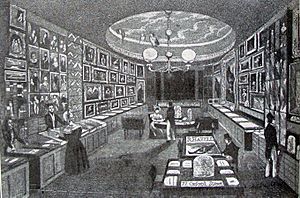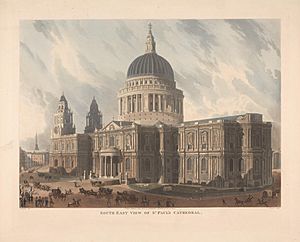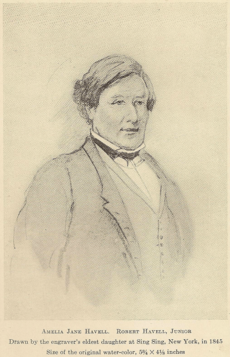Havell family facts for kids
The Havell family from Reading, Berkshire, England, was a very talented family. Many of them were famous engravers, etchers, and painters. Some were also writers, publishers, teachers, and musicians. They were especially good at a type of engraving called aquatint. The family also had a long connection with Indian art and culture. The first famous members were brothers Luke Havell (a drawing master, 1752?–1810) and Robert Havell the Elder (an engraver and publisher, 1769–1832). Their nephew Daniel Havell (an engraver, 1786–1822) was also well-known.
Luke Havell
Luke Havell was born around 1752. He was going to be a farmhand, but a local rich person saw his talent. This led to Luke becoming an apprentice to a sign painter from 1762 to 1764.
He later became the drawing master at Reading Grammar School. He also owned a small print shop in Reading. Luke married Charlotte Phillips in 1778. They had fourteen children together. Two of their famous children were the painter William Havell (1782–1857) and Edmund Havell (1785–1864). Edmund took over the print shop and became the drawing master at the school after his father.
Robert Havell Sr.

Robert Havell Sr. (born December 29, 1769 – died November 21, 1832) owned a printing and engraving shop. He also sold items related to natural history. His shop was in the Marylebone area of London in the early 1800s.
Robert was the brother of Luke Havell. In February 1793, Robert married Lydia Miller Phillips in London. Their oldest son, also named Robert, was born in Reading later that year.
By 1801, Havell had his business at 3 Chapel Street in London. He called himself an "artist." From 1818 to 1825, the business was known as Havell and Son. They became very famous for their skill in aquatint engraving and coloring.
In 1824, Robert moved his business to 79 Newman Street. In 1827, John James Audubon asked him to engrave 240 drawings he had brought from America. This was a huge project. Robert Havell Sr. asked his son, Robert Havell Jr., for help. His son had left London to start his own art career. Robert Havell Jr. agreed to work with his father again. He engraved the plates for Audubon's drawings, while Robert Sr. oversaw the printing and coloring. This father-son team worked together until Robert Havell Sr. retired in 1828.
Robert Sr. passed away in 1832 and was buried in the Old St. Pancras Church graveyard in London.
Daniel Havell

In some older books, Daniel Havell was mistakenly called the father of Robert or Luke. However, newer information shows he was born in 1785. He was the son of Luke's brother, Thomas, who was also a painter.
Daniel moved to London and started a partnership as an aquatint engraver with Robert Havell. Together, they published "Twenty Four Views Taken in St. Helena" (1809–10) and "Twelve Picturesque Views of the River Thames" (1812).
Their partnership didn't last long, and Daniel soon worked on his own. He created plates for Rudolph Ackermann's "History of Cambridge" (1815). He also worked on Ackermann's histories of famous schools like Eton, Winchester, and Rugby (1816). One of his most famous works was a view of St Paul's Cathedral (1818) and other London landmarks for Ackermann's "Repository of Arts." He also engraved views of Devon, North Wales, and naval battles.
Daniel Havell's last known work was for E.W. Brayley's "Historical and descriptive accounts of the theatres of London" (1826). This book featured his beautifully colored drawings and engravings of each theater.
Daniel Havell was baptized on November 30, 1786, in Reading. He married Maria Alice Wilmot in 1813. He was buried on May 19, 1822, in Kingston upon Thames. His job was listed as "artist." His wife later married another artist, John Gendall.
Robert Havell Jr.
Robert Havell Jr. (born November 25, 1793 – died November 11, 1878) was the main engraver for Audubon's famous book, "Birds of America." This book is considered one of the most important natural history publications ever.
Robert Havell Jr.'s aquatint engravings for almost all the plates in "Birds of America" are seen as a huge artistic achievement. His work was key to the book's success. He and John James Audubon became close friends while working together.
In 1839, Havell moved to America at Audubon's invitation, first living in Brooklyn. He later settled in Ossining on the Hudson River and then moved to Tarrytown, New York, where he lived until he passed away.
Even though Havell continued to do aquatint and engraving (mostly city scenes), he spent most of his time painting the beautiful countryside of the Hudson River valley. He often traveled in a special horse-drawn trailer, sketching and taking notes. He would then turn these sketches into larger oil paintings. Robert Havell Jr. is considered a member of the Hudson River School, a group of American landscape painters. He died in 1878 and is buried in Sleepy Hollow Cemetery in New York state.
Luke Havell's Descendants
Here is a list of some of Luke Havell's descendants who are mentioned in books and other sources:
- Luke Havell: A drawing master and painter. He was born in Reading, married Charlotte Phillips in 1778, and died in Reading in 1810.
- William Havell: A landscape painter who used both watercolors and oils. He often showed his work at the Royal Academy. He traveled and painted in China, India, Ceylon (now Sri Lanka), and Italy. He was born in Reading in 1782 and died in Kensington in 1857.
- Edmund Havell: A drawing master and painter who also exhibited at the Royal Academy. He was born in Reading in 1785, married Maria Binfield, and died in 1864.
- Edmund Havell junior: A painter of everyday scenes and portraits, and a lithographer. He often showed his work at the Royal Academy. He was the official portrait artist for Queen Victoria. He also came to America and showed his art at the Centennial in Philadelphia. He was born in Reading in 1819 and died in London in 1899.
- Alfred Charles Havell: A painter of horses and people. He exhibited at the Royal Academy. He was born in Chelsea in 1855, married Mary Marpole Lewis in 1878, and died in 1928.
- Susannah Maria Havell: A musician and music teacher. She worked with her aunt, Hannah Rampton Binfield, who was a composer. She was born in Reading in 1822.
- Charles Richard(s) Havell: A landscape painter who exhibited at the Royal Academy. He was born in Reading in 1828, married Charlotte Amelia Lord in 1855, and died in Caversham in 1892.
- Ernest Binfield Havell: An art writer and educator, especially known for his work on Indian art. He was in charge of Government Art Schools in Madras (now Chennai) and Calcutta (now Kolkata). With Abanindranath Tagore, he helped start the Bengal school of art. He was born in Reading in 1861 and died in Oxford in 1934.
- Herbert Lord Havell: A scholar of classical studies and a writer. His book "Republican Rome" (published after his death in 1914) is still available today. He was born in Reading in 1863 and died in Oxford in 1913.
- Edmund Havell junior: A painter of everyday scenes and portraits, and a lithographer. He often showed his work at the Royal Academy. He was the official portrait artist for Queen Victoria. He also came to America and showed his art at the Centennial in Philadelphia. He was born in Reading in 1819 and died in London in 1899.
- Charles Havell: A painter and drawing master at the Reading School. He was born in Reading in 1792 and married Thirza Cheverton in 1824.
- Henry Havell: A heraldic painter, meaning he painted coats of arms and symbols. He was called "decorator to the King." He was born in Reading in 1796, married Elizabeth Sims in 1821, and moved to the United States in 1829.
- George Havell: A painter who traveled and painted in India. He was born in Reading in 1799, married Mary Ann Hale in 1825, and likely died in India around 1839.
- Frederick James Havell: A steel engraver who also experimented with photography. He was born in Reading in 1801.
- Charles Cedric Havell: The grandson of Charles Richard Havell. He went to Rugby School and Cambridge University. During World War I, he served as an officer in the Suffolk Regiment and became a captain. In 1915, he received the Military Cross for his bravery. After the war, he worked for the Imperial Tobacco Company and eventually became a director.


